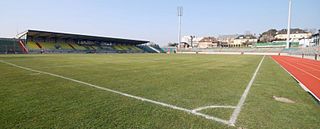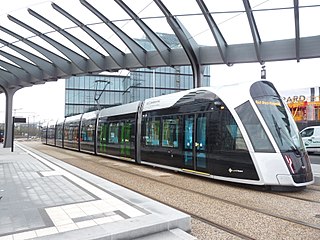
Luxembourg, also known as Luxembourg City, is the capital city of the Grand Duchy of Luxembourg and the country's most populous commune. Standing at the confluence of the Alzette and Pétrusse rivers in southern Luxembourg, the city lies at the heart of Western Europe, situated 213 km (132 mi) by road from Brussels, 372 km (231 mi) from Paris, and 209 km (130 mi) from Cologne. The city contains Luxembourg Castle, established by the Franks in the Early Middle Ages, around which a settlement developed.

The Luxembourg national football team is the national football team of Luxembourg, and is controlled by the Luxembourg Football Federation. The team plays most of its home matches at the Stade Josy Barthel in Luxembourg City.

Stade Josy Barthel is the national stadium of Luxembourg, home to the Luxembourg national football team and also used for rugby union and athletics. It is located on route d'Arlon, in the Luxembourg City quarter of Belair.
Joseph ("Josy") Barthel was a Luxembourgish athlete. He was the surprise winner of the Men's 1500 metres at the 1952 Summer Olympics, and the only athlete representing Luxembourg to have won a gold medal at the Olympics. Besides athletics, Barthel also led successful careers in both chemistry and politics.

F91 Dudelange, or F91 Diddeleng, is a Luxembourgish professional football club based in Dudelange which plays in the Luxembourg National Division.
The 2006 UEFA European Under-17 Championship was the fifth edition of UEFA's European Under-17 Football Championship. Luxembourg hosted the championship, during May 3–14. Russia defeated the Czech Republic in the final to win the competition for the second time. Players born after 1 January 1989 could participate in this competition.
The Stade de la Frontière is a multi-purpose stadium in Esch-sur-Alzette, Luxembourg. It is currently used mostly for football matches and is the home stadium of Jeunesse Esch. The stadium holds 8.200 people.

Belair (formerly:"Neumerl") is a quarter in western Luxembourg City, in southern Luxembourg.

Unlike in most countries in Europe, sports in Luxembourg are not concentrated upon a particular national sport, but encompasses a number of sports, both team and individual. Despite the lack of a central sporting focus, over 100,000 people in Luxembourg, which has a total population of only 460,000, are licensed members of one sports federation or another.
Football in Luxembourg is governed by the Luxembourg Football Federation (FLF), which is a member of FIFA and UEFA. The FLF organises the men's, women's and futsal national teams, in addition to the main domestic competitions, the National Division and the Luxembourg Cup.
The 2006 FIFA World Cup qualification UEFA Group 3 was a UEFA qualifying group for the 2006 FIFA World Cup. The group comprised Estonia, Latvia, Liechtenstein, Luxembourg, Portugal, Russia and Slovakia.

The first generation of trams in Luxembourg ran from 1875 to 1964, before being withdrawn from service and the tramways removed. A second generation of trams began operational service in December 2017, along a new route that will, by 2021, run from Luxembourg Airport to the Cloche d'Or business district.
This page shows the standings and results for Group D of the UEFA Euro 2012 qualifying tournament.
Standings and results for Group 5 of the UEFA Euro 2000 qualifying tournament.
Standings and results for Group 5 of the UEFA Euro 1996 qualifying tournament.

The Nouveau Stade de Bordeaux, currently also known as the Matmut Atlantique for sponsorship purposes, is a football stadium in Bordeaux, France. It is the home of Ligue 1 club FC Girondins de Bordeaux and seats 42,115 spectators.
The 2014 FIFA World Cup qualification UEFA Group F was a UEFA qualifying group for the 2014 FIFA World Cup. The group was one of nine qualifying groups from UEFA and comprised Azerbaijan, Israel, Luxembourg, Northern Ireland, Portugal and Russia.
The 2018 FIFA World Cup qualification UEFA Group A was one of the nine UEFA groups for 2018 FIFA World Cup qualification. The group consisted of six teams: Netherlands, France, Sweden, Bulgaria, Belarus, and Luxembourg.
Group 5 consisted of five of the 50 teams entered into the European zone: Bulgaria, Cyprus, Israel, Luxembourg, and Russia. These five teams competed on a home-and-away basis for two of the 15 spots in the final tournament allocated to the European zone, with the group's winner and runner-up claiming those spots.
The Euroforum building is an office complex used by the European Commission in Cloche d'Or, Gasperich, Luxembourg City, Luxembourg. It hosts, amongst other European Commission departments, the Euratom Supply Agency.










